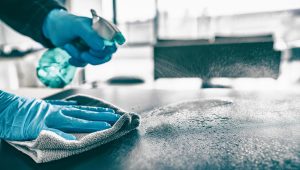 Early in the pandemic, it became normal to sanitize everything all the time. I remember taking about 30 minutes to wipe down all my groceries, countertops, and door handles upon returning from a trip to the market.
Early in the pandemic, it became normal to sanitize everything all the time. I remember taking about 30 minutes to wipe down all my groceries, countertops, and door handles upon returning from a trip to the market.
But times have changed. A combination of COVID fatigue set in, and I, like many others, came back to earth and recognized that maybe all that wasn’t necessary. Now, the CDC is saying all that sanitizing probably isn’t needed.
Advertisement
New data is simply showing what we really didn’t know before: coronavirus doesn’t really live long on surfaces and is not easily transmissible.
Of course, that doesn’t mean there are zero risks, but more so that it is very low. High-traffic areas can be washed with soap and water, but the real focus should be on hand hygiene and limited facial touching.
Put simply, wash your hands after you arrive home, and put your groceries away while avoiding facial contact between washes.
You don’t need to disinfect your surfaces—a wash with soap and warm water should do the trick.
When out, avoid touching high-contact surfaces when possible, and sanitize your hands afterward.
Advertisement
The SARS-CoV-2 virus mainly spreads through respiratory droplets and aerosol transmission, meaning it is breathed in. Therefore, the best defense against the illness is wearing a three-layered mask and avoiding close contact with other individuals.
So, if you’ve been obsessively sanitizing surfaces and everything coming into your home for the past 13 months, you can take a breather and cut down your use of sanitary wipes and disinfectants.
Just be sure to keep washing your hands, avoid rubbing your eyes and nose, and remember to keep wearing a mask and observe social distancing recommendations even if you’ve been vaccinated.
